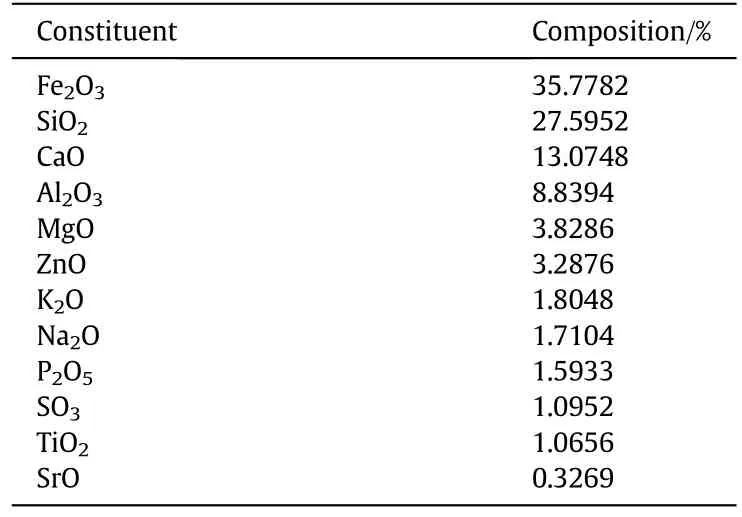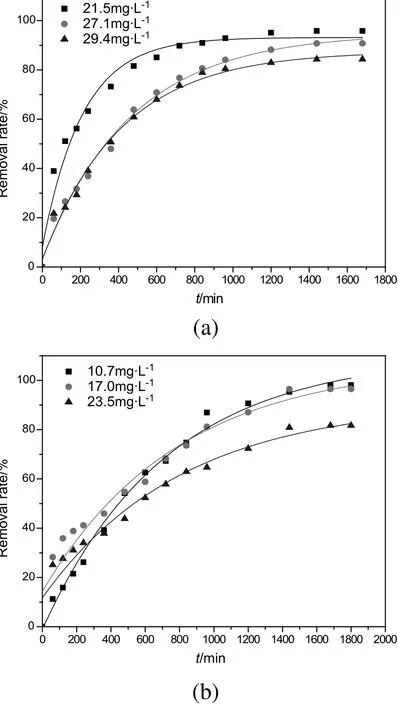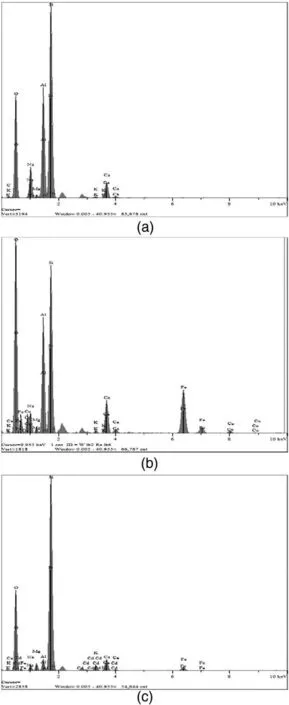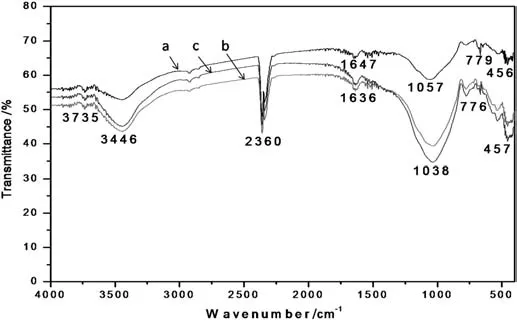Adsorption characteristics of a novel ceramsite for heavy metal removal from storm water runoff☆
Jianlong Wang *,Yuanling Zhao Pingping Zhang 2,Liqiong Yang ,Huai’ao Xu Guangpeng Xi
1 Key Laboratory of Urban Storm water System and Water Environment of the Ministry of Education,Beijing University of Civil Engineering and Architecture,Beijing 100044,China
2 State Key Laboratory of Water Environment Simulation,School of Environment,Beijing Normal University,Beijing 100875,China
3 Jiuquan Environmental Monitoring Branch,Jiuquan 735000,China
1.Introduction
Owing to rapid urbanization,impervious surfaces have markedly increased in urban areas,and storm water runoff has increased both in total volume and peak flow rate[1].Consequently,urban surface water quality has deteriorated as sewer pipe sediments(SPS)and river bed sediments(RBS)have become increasingly serious under storm water flushing[2–4].In addition,with increasing populations and industrialization,larger amounts of municipal sludge such as water supply treatment sludge(WSTS)and wastewater treatment sludge(WWTS)are being produced[5,6].
SPS presents a widespread and serious problem owing to storm water flushing and a lack of daily sewer maintenance(especially in the old districts of many cities),because the sediments reduce the capacity of drainage pipes,increase hydraulic resistance,and produce over flow pollution in heavy rainfall events[3].Although several studies on SPS have mainly focused on the relationships influencing its flushing,composition,and impacts on receiving waters[7–11],research on SPS disposal methods is limited.Likewise,RBS pollution has become more serious owing to the accumulation of toxic pollutants,and its unreasonable disposal has been investigated by some researchers.Nevertheless,owing to its inorganic particles,RBS has been examined as a resource(e.g.for making bricks and ceramsite)and an agricultural input[4,12,13].
Conventional water supply treatment usually includes coagulation,flocculation, filtration,sedimentation,and disinfection,and generates WSTS that contains large amounts of Fe and Al[5,14,15].Owing to its chemical properties,WSTS has been studied as a low-cost adsorbent for removing pollutants such as ammonium[16],phosphorus[17],and arsenate[18].Similarly,WWTS is generated during wastewater treatment after dewatering of excess activated sludge.It contains large quantities of organic matter,pathogenic bacteria,and harmful substances.Some researchers have shown that WWTS could be used as a foaming agent in ceramsite production[5,19].
Currently,the disposal of the four sediments,SPS,RBS,WSTS,and WWTS,hasbeen attracting widespread attention.Owing to increasingly stringent sludge disposal regulations,both public and private sediment generators are being forced to re-evaluate their sediment management strategies.As a result,new energy-saving and environment-friendly urban sediment management techniques are urgently needed.Nowadays,sustainable development and natural resources preservation have gained significant importance.With the restriction of clay brick and its products,the application of clay as a raw material of ceramsite is limited[20].According to He et al.[5],a variety of raw materials can be used to form ceramsite if the chemical composition of the materials(without any additives)is in the following ranges(%):SiO2,48–68;Al2O3,12–18;Fe2O3,5–10;and K2O+N2O,2.5–7.0.As the four urban sediments contain inorganic components such as Al2O3,SiO2,Fe2O3,CaO,MgO,Na2O,and K2O(Table 1),these problematic sediments have the potential to be the raw materials for the development of a novel ceramsite.In addition,some researchers have shown that heavy metals in sludge-based ceramsite were immobilized and could not be easily released into the environment to cause secondary pollution[21–24].Therefore,a new effective approach to manage the four urban sediments is to produce ceramsite,which can both overcome constraints on raw material use and convert the problematic sediments into a resource.

Table 1 Chemical characteristics of the four sediments(%)
Heavy metal contamination is a serious problem that has prompted considerable research.In contrast to most of the organic pollutants,heavy metals are difficult to degrade in the natural environment and are easily accumulated in living organisms,thereby causing various diseases and disorders[25–27].Cd is readily taken up by growing plants from contaminated soil and enters the human food chain,leading to acute and chronic diseases[28–30].Excessive intake of Cu by humans may irritate the mucous membranes,leading to hepatic and renal damage,widespread capillary damage,and central nervous system problems[31–33].Various methods have been developed to remove heavy metals from water such as chemical precipitation,membrane filtration,and adsorption[23,34,35].Among them,adsorption has been regarded as an important process owing to its simplicity and efficiency[36–39].
The key objective of successful application of sorption technology is to find a cost-effective,environment-friendly,and high-performance sorbent.The traditional sorbents applied in the removal of Cd mainly include zeolites,clays,activated carbons,biomass,and polymeric materials,none of which are cost-effective.However,in recent years,some low-cost waste byproducts have been used as the sorbent for removing heavy metals.An et al.[26]investigated an adsorbent based on jujube for the removal of toxic heavy metals.Hegazi[40]showed that agricultural and industrial waste byproducts such as rice husk and fly ash could be used for removing heavy metals from wastewater.Chen et al.[41]demonstrated that a novel ceramic adsorbent developed with a mixture of akadama mud,wheat starch,and Fe2O3could be used for arsenic removal from a water solution.Zou et al.[42]tested the nitrogen removal capacity of a self-made sludge-based ceramsite used as a carrier in a bio filter.Therefore,removal of Cu2+and Cd2+from storm water runoff using a novel ceramsite adsorbent made from a mixture of four urban sediments seems reasonable,and if successful,could lay a foundation for applying ceramsite as a bioretention medium to reduce storm water runoff pollution.
The objectives of this study were to develop a novel ceramsite based on the four urban sediments(SPS,RBS,WSTS,and WWTS)and Na2SiO3,and to evaluate its Cu2+and Cd2+adsorption properties through dynamic and isothermal experiments combined with material characterization analysis.
2.Materials and Methods
2.1.Optimization of ceramsite composition
SPS,RBS,WSTS,and WWTS were obtained from the following locations in Beijing,China:a road at Chegongzhuang West,a river near the Xizhimen subway station,the third water supply treatment plant of Beijing,and the Gaobeidian wastewater treatment plant,respectively.Na2SiO3was used as an adhesive.The chemical characteristics of the four sediments are shown in Table 1.
The four sediments were dried by natural aeration,crushed into powders using a universal pulverizer,and mixed with Na2SiO3according to the optimum ratio determined from orthogonal test.The factors and levels of the orthogonal design are shown in Table2.The orthogonal test scheme and result analysis are presented in Table 3.The amount of SPS was considered to be a constant in the experiment,and the other four materials were considered as the main factors.Four levels of each factor were evaluated,creating an L16(45)orthogonal design.The Brunauer–Emmett–Teller(BET)specific surface area of the ceramsite was used as the assessment indicator owing to itsimpactson adsorption efficiency.The optimal mix(proportions of the four materials)wasdetermined as described previously[43].Wet ceramsite samples of approximately 10 mm diameter were manually developed,dried for 30 min at 105 °C in an oven,pretreated for 20 min at 400 °C in a muffle furnace,roasted for 5 min at 1100°C,and then cooled to obtain the ceramsite used in the experiments[5,14].

Table 2 Factors and levels of the orthogonal design

Table 3 Orthogonal test and resulting BET values
2.2.Adsorption experiments
2.2.1.Adsorption isotherms
Adsorption isotherms can be determined by the adsorption process and mechanism.Often,the Langmuir and Freundlich isotherm models are used to describe the adsorption process of a material.The Langmuir adsorption isotherm can be expressed as[44]:

where Qeis the equilibrium absorption amount(mg·g−1),Qmis the saturated adsorption amount(mg·g−1),Ceis the concentration of heavy metals(Cu2+and Cd2+)in solutions at equilibrium(mg·L−1),and KLis the Langmuir adsorption constant.
The Freundlich adsorption isotherm can be expressed as[45]:

where Kfis the Freundlich adsorption constant,n is a constant,and other terms are as defined previously.
To investigate the adsorption isotherm,5 g·L−1ceramsite was respectively placed in five conical flasks,each containing a different concentration of Cu2+and Cd2+solution(300 ml;from Cu Cl2·H2O and Cd Cl2·H2O,respectively).The p H of these solutions was adjusted to 6.0–7.0,which is close to the p H of storm water runoff(p H=5–7).The Cu2+concentrations used were 21.5,22.2,27.1,29.4,and 32.1 mg·L−1,and the Cd2+concentrations employed were 15.3,17.0,19.3,23.5,and 32.1 mg·L−1.The five conical flasks were maintained at(25±1)°Cand shaken at 160 rpm on a shaking table.During shaking,the samples were obtained at certain times to determine the point of adsorption equilibrium.Then,the correlation coefficients of adsorption isotherms,defined using Eqs.(1)and(2),were determined.
2.2.2.Adsorption kinetics
Adsorption kinetics models can be used to explain the inherent law and essential process of adsorption.Often,a pseudo- first-order kinetic equation and a pseudo-second-order kinetic equation are used.The pseudo- first-order kinetic equation can be given as[46]:

where Qtis the absorption amount at time t(mg·g−1)and k1is the equilibrium rate constant.
The pseudo-second-order kinetic equation can be expressed as[47]:

where k2is the equilibrium rate constant.
The 5 g·L−1ceramsite was chosen as the research object,and the experimental conditions included 160 rpm and(25±1)°C.The Cu2+concentrations employed were 21.5,27.1,and 29.4 mg·L−1,and the Cd2+concentrations used were 10.7,17,and 23.5 mg·L−1.Sampling was performed at a certain time interval,and the samples were analyzed using a flame atomic absorption spectrophotometer(Z-2010,Hitachi,Tokyo,Japan).
2.3.Characterization methods
The specific surface area and pore-size distributions of the novel ceramsite were determined by gas adsorption using a BET specific surface analysis device(Mike ASAP 2020,USA).The chemical oxide composition was determined using a scanning wavelength dispersive X-ray fluorescence(XRF)instrument(Shimadzu XRF-1800).Scanning electron microscopy(SEM),energy dispersive spectrometry(EDS),and a Fourier transform infrared(FTIR)spectrometer(Vertex 20 V FTIR spectrometer,Bruker,Germany)were used to characterize the ceramsite before and after adsorption.The SEM and EDS were accomplished using a Hitachi SU8010 cold field emission scanning electron microscope.
3.Results and Discussion
3.1.Characterization of the novel ceramsite
The orthogonal test design and BET analysis results are presented in Table 3.The different range values were RA=2.4897,RB=4.4623,RC=3.668,and RD=1.3152.Thus,RB>RC>RA>RD,and the order of impact of the four materials on BET was as follows:WSTS>RBS>WWTS>Na2SiO3.The orthogonal test revealed that the optimal mixture of the components for the development of novel ceramsite was A3B4C2D3,which consisted of(in proportions relative to SPS)20%WSTS,15%RBS,15%WWTS,and 10%Na2SiO3.Although the chemical composition of RBS is more consistent with the technical requirements for ceramsite developed,when compared with that of WSTS,the burning loss of WSTS during combustion is relatively higher,contributing to the formation of porous ceramsite[5,48].Therefore,the mass of WSTS produced the highest Influence on the BET of ceramsite.The addition of Na2SiO3could initiate Al3+and Si4+to form a stable skeleton structure,resulting in certain solidity of the ceramsite and laying a foundation for its application as a filter medium[24].The chemical composition of the ceramsite was similar to that reported previously[49,50](Table 4).The BET specific surface area of the novel ceramsite was 0.4967 m2·g−1and the pore size was 9.983 nm.

Table 4 Chemical analysis of the novel ceramsite composition
3.2.Adsorption characteristics
3.2.1.Cu2+and Cd2+removal efficiency of the novel ceramsite

Fig.1.The Cu2+(a)and Cd2+(b)removal rate(efficiency)of the novel ceramsite.

Fig.2.Langmuir(a)and Freundlich(b)isotherms for Cu2+adsorption.
Most of the previous studieshave focused on methods of developing sludge ceramsite,and there are only a few studies on Cu2+and Cd2+adsorption by ceramsite.Fig.1 shows that the equilibrium time of Cu2+and Cd2+adsorption by the novel ceramsite exceeded 20 h.The time to reach Cu2+and Cd2+equilibrium was about 950 and 1700 min,respectively,and Cu2+adsorption was more stable than Cd2+adsorption.The best removal rate for both the metals was 100%,and the Cu2+and Cd2+equilibrium adsorption amount was 4.96 and 3.84 mg·g−1,respectively.These results confirmed that both Cu2+and Cd2+can be effectively removed by the novel ceramsite.In a previousstudy,Xing et al.[39]showed that the maximum Cu2+removal efficiency of red loess was 100%at p H 8.Qin et al.[51]demonstrated that ceramsite made with lime mud and coal fly ash could be a highperformance product for wastewater recycling.In the present study,the longer equilibrium time and instability in the adsorption may be related to the adsorption mechanism,conditions of adsorption,and compositions of ceramsite.
3.2.2.Adsorption isotherms
Figs.2 and 3 show the Langmuir and Freundlich isotherms for Cu2+and Cd2+adsorption,respectively,and Table 5 presents the parameters of the Langmuir and Freundlich equations for Cu2+and Cd2+adsorption.The correlation coefficients showed that the Langmuir model described the adsorption process of Cu2+and Cd2+better than the Freundlich model,and that Cu2+and Cd2+adsorption on the ceramsite was characterized by monolayer sorption.Similar resultshave also been reported in previous studies on Cu2+and Cd2+adsorption on other sorbent materials[39,52–56].
The value of the parameter RLdescribes the affinity between adsorbent and adsorbate,which can reflect the adsorption process[57].The RLequation can be given as:

where C0is the initial concentration of Cu2+and Cd2+in solution(mg·L−1).When 0 < RL< 1,the adsorption process proceeds easily;when RL=1,the adsorption process is a linear function;when RL=0,the adsorption is irreversible;and when RL>1,the system is not conducive to adsorption[58,59].In the present study,all the RLvalues were between 0 and 1;thus,it can be concluded that the developed ceramsite exhibited good affinity for Cu2+and Cd2+and could feasibly be used for the adsorption and removal of these metals from water.
3.2.3.Adsorption kinetics

Fig.3.Langmuir(a)and Freundlich(b)isotherms for Cd2+adsorption.

Table 5 Parameters for Langmuir and Freundlich equations for Cu2+and Cd2+adsorption
Figs.4 and 5 showthe kinetic curves depicting Cu2+and Cd2+adsorption by the developed ceramsite,and Table 6 liststhe parameters for kinetic models describing the adsorption process.The comparison between pseudo- first-and pseudo-second-order kinetics revealed that the R2values(0.9971,0.9846,0.9811)of the pseudo- first-order kinetics model for Cu2+adsorption were reasonably higher than those of the pseudo-second-order kinetics model(0.9985,0.9769,0.9772).Furthermore,the R2values(0.9591,0.9556,0.9705)of the pseudofirst-order kinetics model describing Cd2+adsorption were obviously higher than those of the pseudo-second-order kinetics model(0.9340,0.9447,0.9443).Therefore,it can be concluded that pseudo- first-order kinetics provided a better description of both Cu2+and Cd2+adsorption(especially Cu2+adsorption)by the novel ceramsite than the pseudo-second-order kinetics.This finding indicated that adsorption efficiency was related to the effective adsorption sites of the ceramsite,initial concentration of the heavy metal solution,adsorption rates,and increased interaction time.These results are similar to those reported by Azizian[60],Bhattacharyya and Gupta[61],and Liu et al.[62].

Fig.4.Kinetic equation fitting curve depicting Cu2+adsorption.(a)pseudo- first-order kinetics;(b)pseudo-second-order kinetics.
3.3.Adsorption mechanism analysis
Fig.6 shows the SEM image of the novel ceramsite before and after Cu2+and Cd2+adsorption.It can be noted from the figure that the surface of the ceramsite became smoother after Cu2+and Cd2+adsorption,which could probably be owing to the filling of poresby Cu2+and Cd2+.Sometiny pores in ceramsitecould provide the bas is for the physical adsorption function.Fig.7 presents the EDS results of the novel ceramsite before and after adsorption,which clearly showthe adsorbed Cu and Cd elements.These results indicated that the novel ceramsite allowed physical adsorption of Cu2+and Cd2+.In a previous study,Frost et al.[63]reported that SEM imaging and EDS analysis could be used to demonstrate the presence of Al,F,and S in the sulfate mineral.

Fig.5.Kinetic equation fitting curve depicting Cd2+adsorption.(a)pseudo- first-order kinetics;(b)pseudo-second-order kinetics.
Fig.8 illustrates the FTIR spectra of the novel ceramsite before and after Cu2+and Cd2+adsorption.Several peaks can be observed in the figure,suggesting that kaolinite is composed of various functional groups that are responsible for the binding of cations.It must be noted that the absorption band from 2360 to 4000 cm−1was unaffected before and after adsorption,revealing the absence of smectite in kaolinite[64].The absorption peaks near 1647 and 1057 cm−1can be attributed to the angular vibration of structural water and C--O bond stretching vibration of as mall amount of carboxylate,respectively,and the absorption peak at 1057 cm−1corresponded to the carbohydrate from ceramsite and C--O stretching vibration.The Si--O stretching vibration was observed at 779 cm−1,and the peak intensity recorded at 456 cm−1can beattributed to Al--O--Siskeletal vibrations[65].Similar spectra were noted after Cu2+and Cd2+adsorption by the novel ceramsite.The shifts in the C--O bond were observed from 1647 to 1636 cm−1following Cu2+adsorption,and from 1057 to 1038 cm−1following Cd2+adsorption.In addition,there was a shift in Si--O stretching vibration from 779 to 776 cm−1and a minor shift in the Al--O--Si skeletal vibration.These results indicated that the novel ceramsite initiated chemical adsorption of Cu2+and Cd2+.Similar results were also reported by Dawodu and Akpomie[66]who analyzed the FTIR spectrum of chemical constitution changes before and after Cd(II)adsorption by Nigerian kaolinite clay.

Fig.6.SEM images of ceramsite before(a)and after adsorption of Cu2+(b)and Cd2+(c).

Table 6 Parameters for Cu2+and Cd2+adsorption kinetic models

Fig.7.EDS of ceramsite before(a)and after adsorption of Cu2+(b)and Cd2+(c).

Fig.8.FTIR spectrum of ceramsite before(a)and after ad sorption of Cu 2+(b)and Cd 2+(c).
4.Conclusions
A novel ceramsite was developed by combining four urban sediments(SPS,WSTS,RBS,and WWTS)and a binder(Na2SiO3)at an optimal composition of(in proportion relative to SPS)20%WSTS,15%RBS,15%WWTS,and 10%Na2SiO3.The novel ceramsite could effectively remove Cu2+and Cd2+,and the adsorption process could be better described by the Langmuir isotherm and pseudo- first-order kinetics.The adsorption of Cu2+and Cd2+by the novel ceramsite involved both physical and chemical processes.Therefore,the novel ceramsite can be used as a sorbent for removing dissolved heavy metals from storm water runoff.In addition,the developed ceramsite presented the characteristic of solidity,suggesting its potential application as a bioretention medium to purify storm water.
[1]W.Jianlong,Z.Pingping,Y.Liqiong,et al.,Adsorption characteristics of construction waste for heavy metals from urban stormwater runoff,Chin.J.Chem.Eng.23(2015)1542–1550.
[2]C.Y.Fan,Sewer Sediment and Control:A Management Practices Reference Guide,United States Environmental Protection Agency,washington,2004.
[3]G.Yuan,W.Hongwu,Z.Shanfa,et al.,Current research progress in combined sewer sediments and their models,China Water Wastewater 2(27)(2010)15–18,27.
[4]L.Guiyun,J.Peihua,Study on importance and approaches to the reutilization of river sediment,J.Donghua Univ.Nat.Sci.1(2002)33–36.
[5]H.Jun,W.Qishan,R.Ailing,Technology research on waterworks sludge and sewage sludge for ceramsite,Chin.J.Environ.Eng.9(2009)1653–1657.
[6]W.Jing,L.Zongwen,T.Shun,et al.,Existing state and development of sludgy researches in domestic and foreign,Munic.Eng.Technol.24(3)(2006)140–142.
[7]C.Becouze-Lareure,L.Thiebaud,C.Bazin,et al.,Dynamics of toxicity within different compartments of a peri-urban river subject to combined sewer over flow discharges,Sci.Total Environ.539(2016)503–514.
[8]I.Ebtehaj,H.Bonakdari,S.Shamshirband,et al.,A combined support vector machine-wavelet transform model for prediction of sediment transport in sewer,Flow Meas.Instrum.47(2016)19–27.
[9]L.Yiwen,N.Bingjie,R.Ganigué,et al.,Sul fide and methane production in sewer sediments,J.Water Res.70(2015)350–359.
[10]J.Mattsson,A.Hedström,R.M.Ashley,et al.,Impacts and managerial implications for sewer systems due to recent changes to inputs in domestic wastewater–A review,J.Environ.Manag.161(2015)188–197.
[11]R.Sakrabani,J.Vollertsen,R.M.Ashley,et al.,Biodegradability of organic matter associated with sewer sediments during first flush,Sci.Total Environ.407(8)(2009)2989–2995.
[12]L.Guiyun,X.Danli,Experiment on producing ceramisite with river sediment,J.Donghua Univ.Nat.Sci.4(94)(2003)81–83,94.
[13]W.S.W.Salim,S.F.Sadikon,S.M.Salleh,et al.,Assessment of physical properties and chemical composition of Kuala Perlis dredged marine sediment as a potential brick material,Business,Engineering and Industrial Applications(ISBEIA),IEEE Symposium on,IEEE 2012,pp.509–512.
[14]H.Jun,W.Qishan,R.Ailing,Technology research on the production of high strength ceramsite by waterworks sewage,Ind.Saf.Environ.Prot.11(2010)51–52.
[15]T.Yuanyuan,C.Siuwai,K.Shih,Copper stabilization in beneficial use of waterworks sludge and copper-laden electroplating sludge for ceramic materials,Waste Manag.34(6)(2014)1085–1091.
[16]Y.Lan,J.Wei,L.Zhongyuan,et al.,Material prepared from drinking waterworks sludge as adsorbent for ammonium removal from wastewater,Appl.Surf.Sci.330(2015)228–236.
[17]Y.Lan,J.Wei,Z.Yumei,et al.,Reuse of acid coagulant-recovered drinking waterworks sludge residual to remove phosphorus from wastewater,Appl.Surf.Sci.305(2014)337–346.
[18]M.K.Gibbons,G.A.Gagnon,Adsorption of arsenic from a Nova Scotia groundwater onto water treatment residual solids,J.Water Res.44(19)(2010)5740–5749.
[19]H.Jun,W.Qishan,R.Ailing,Use of sewage sludge for manufacturing light ceramsite,Urban Environ.Urban Ecol.16(6)(2003)13–14.
[20]L.C.Herek,C.E.Hori,M.H.M.Reis,et al.,Characterization of ceramic bricks incorporated with textile laundry sludge,Ceram.Int.38(2)(2012)951–959.
[21]Y.Jian,Z.Chunhui,X.Meiyan,et al.,Enhancement stabilization of heavy metals(Zn,Pb,Cr and Cu)during vermifiltration of liquid-state sludge,Bioresour.Technol.146(2013)649–655.
[22]L.Xingwen,S.Kaimin,C.Hefa,Lead glass-ceramics produced from the beneficial use of waterworks sludge,J.Water Res.47(3)(2013)1353–1360.
[23]T.Wang,W.Liu,N.Xu,et al.,Adsorption and desorption of Cd(II)onto titanate nanotubes and efficient regeneration of tubular structures,J.Hazard.Mater.250(2013)379–386.
[24]X.Guoren,L.Mingwei,L.Guibai,Stabilization of heavy metals in lightweight aggregate made from sewage sludge and river sediment,J.Hazard.Mater.260(2013)74–81.
[25]K.G.Akpomie,F.A.Dawodu,K.O.Adebowale,Mechanism on the sorption of heavy metals from binary-solution by a lowcost montmorillonite and its desorption potential,Alex.Eng.J.54(3)(2015)757–767.
[26]B.An,C.G.Lee,M.K.Song,et al.,Applicability and toxicity evaluation of an adsorbent based on jujube for the removal of toxic heavy metals,React.Funct.Polym.93(2015)138–147.
[27]S.E.Bailey,T.J.Olin,R.M.Bricka,et al.,A review of potentially low-cost sorbents for heavy metals,J.Water Res.33(11)(1999)2469–2479.
[28]A.Oskarsson,A.Widell,M.Olsson,et al.,Cadmium in food chain and health effects in sensitive population groups,Biometals 17(5)(2004)531–534.
[29]E.W.Shin,R.M.Rowell,Cadmium ion sorption onto lignocellulosic biosorbent modified by sulfonation:The origin of sorption capacity improvement,Chemosphere 60(8)(2005)1054–1061.
[30]Z.Guoping,M.Fukami,H.Sekimoto,Influence of cadmium on mineral concentrations and yield components in wheat genotypes differing in Cd tolerance at seedling stage,Field Crops Res.77(2)(2002)93–98.
[31]L.M.Gaetke,C.K.Chow,Copper toxicity,oxidative stress,and antioxidant nutrients,Toxicology 189(1)(2003)147–163.
[32]S.Larous,A.H.Meniai,M.B.Lehocine,Experimental study of the removal of copper from aqueous solutions by adsorption using sawdust,Desalination 185(1)(2005)483–490.
[33]W.Hao,S.Qiyong,L.Haibo,et al.,Screen-printed gold electrode with gold nanoparticles modification for simultaneous electrochemical determination of lead and copper,Sensors Actuators B Chem.209(2015)336–342.
[34]M.M.Matlock,B.S.Howerton,D.A.Atwood,Chemical precipitation of heavy metals from acid mine drainage,J.Water Res.36(19)(2002)4757–4764.
[35]S.R.Younesi,H.Alimadadi,E.K.Alamdari,et al.,Kinetic mechanisms of cementation of cadmium ions by zinc powder from sulphate solutions,Hydrometallurgy 84(3)(2006)155–164.
[36]W.W.Ngah,M.A.K.M.Hana fiah,Removal of heavy metal ions from wastewater by chemically modified plant wastes as adsorbents:A review,Bioresour.Technol.99(10)(2008)3935–3948.
[37]A.Roy,J.Bhattacharya,A binary and ternary adsorption study of wastewater Cd(II),Ni(II)and Co(II)by γ-Fe2O3nanotubes,Sep Purif.Technol.115(2013)172–179.
[38]C.H.Xiong,C.P.Yao,Study on the adsorption of cadmium(II)from aqueous solution by D152 resin,J.Hazard.Mater.166(2)(2009)815–820.
[39]X.Shengtao,Z.Meiqing,M.Zichuan,Removal of heavy metal ions from aqueous solution using red loess as an adsorbent,J.Environ.Sci.23(9)(2011)1497–1502.
[40]H.A.Hegazi,Removal of heavy metals from wastewater using agricultural and industrial wastes as adsorbents,HBRC J.9(3)(2013)276–282.
[41]C.Rongzhi,Z.Zhenya,F.Chuanping,et al.,Application of simplex-centroid mixture design in developing and optimizing ceramic adsorbent for As(V)removal from water solution,Microporous Mesoporous Mater.131(1)(2010)115–121.
[42]Z.Jinlong,X.Guoren,K.Pan,et al.,Nitrogen removal and bio film structure affected by COD/NH4+–N in a bio filter with porous sludge-ceramsite,Sep.Purif.Technol.94(2012)9–15.
[43]X.Guoren,Z.Jinlong,L.Guibai,Ceramsite made with water and wastewater sludge and its characteristics affected by SiO2and Al2O3,J.Environ.Sci.Technol.42(19)(2008)7417–7423.
[44]I.Langmiur,The constitution and fundamental properties of solids and liquids,J.Am.Chem.Soc.38(11)(1916)2221–2295.
[45]H.M.F.Freundlich,Uber die adsorption in losungen,Z.Phys.Chem.A 57(1906)385–470.
[46]S.Lagergren,K.Svenska,About the theory of so-called adsorption of soluble substances,K.Sven.Vetenskapsakad.Handl.24(1898)1–39.
[47]Y.S.Ho,G.Mckay,Pseudo-second order model for sorption processes,Process Biochem.34(5)(1999)451–456.
[48]C.M.Riley,Relation of chemical properties to the bloating of clays,J.Am.Ceram.Soc.34(4)(1951)121–128.
[49]X.Shuhong,M.Chunyan,Z.Jingwei,et al.,Application of orthogonal design and regression analysis on ceramsite made of river sediment,Concrete 12(2008)022.
[50]X.Guoren,Z.Jinlong,Y.Dai,Utilization of dried sludge for making ceramsite,Water Sci.Technol.54(9)(2006)69–79.
[51]Q.Jun,C.Chong,C.Xiaoyu,et al.,Preparation and characterization of ceramsite from lime mud and coal fly ash,Constr.Build.Mater.95(2015)10–17.
[52]D.Jinming,S.Bing,Removal characteristics of Cd(II)from acidic aqueous solution by modified steel-making slag,Chem.Eng.J.246(2014)160–167.
[53]J.H.Potgieter,S.S.Potgieter-Vermaak,P.D.Kalibantonga,Heavy metals removal from solution by palygorskite clay,Miner.Eng.19(5)(2006)463–470.
[54]S.Weiling,J.Bofeng,W.Fei,et al.,Effect of carbon nanotubes on Cd(II)adsorption by sediments,Chem.Eng.J.264(2015)645–653.
[55]W.Pingxiao,Z.Qian,D.Yaping,X.Wang,et al.,Adsorption of Cu(II),Cd(II)and Cr(III)ions from aqueous solutions on humic acid modified Ca-montmorillonite,Geoderma 164(3)(2011)215–219.
[56]W.Pan,D.Mingliang,Z.Han,et al.,Structure regulation of silica nanotubes and their adsorption behaviors for heavy metal ions:p H effect,kinetics,isotherms and mechanism,J.Hazard.Mater.286(2015)533–544.
[57]T.W.Weber,R.K.Chakravorti,Pore and solid diffusion mod els for fixed-bed adsorbers,AIChE J.20(2)(1974)228–238.
[58]M.M.Rao,A.Ramesh,G.P.C.Rao,K.Seshaiah,Removal of copper and cadmium from the aqueous solutions by activated carbon derived from Ceiba pentandra hulls,J.Hazard.Mater.129(1)(2006)123–129.
[59]M.F.Sawalha,J.R.Peralta-Videa,J.Romero-Gonzalez,et al.,Thermodynamic and isotherm studies of the biosorption of Cu(II),Pb(II),and Zn(II)by leaves of saltbush(Atriplex canescens),J.Chem.Thermodyn.39(3)(2007)488–492.
[60]S.Azizian,Kinetic models of sorption:A theoretical analysis,J.Colloid Interface Sci.276(1)(2004)47–52.
[61]K.G.Bhattacharyya,S.S.Gupta,Removal of Cu(II)by natural and acid-activated clays:An insight of adsorption isotherm,kinetic and thermodynamics,Desalination 272(1)(2011)66–75.
[62]L.Weifeng,Z.Jian,C.Cheng,et al.,Ultrasonic-assisted sodium hypochlorite oxidation of activated carbons for enhanced removal of Co(II)from aqueous solutions,Chem.Eng.J.175(2011)24–32.
[63]R.L.Frost,R.Scholz,R.M.F.Lima,et al.,SEM,EDS and vibrational spectroscopic study of the sulphate mineral rostite AlSO4(OH,F)·5(H2O),Spectrochim.Acta A Mol.Biomol.Spectrosc.151(2015)616–620.
[64]G.I.E.Ekosse,Fourier transform infrared spectrophotometry and X-ray powder diffractometry as complementary techniques in characterizing clay size fraction of Kaolin,J.Appl.Sci.Environ.Mgt.9(2)(2005)43–48.
[65]A.B.Đukić,K.R.Kumrić,N.S.Vukelić,et al.,Influence of ageing of milled clay and its composite with TiO2on the heavy metal adsorption characteristics,J.Ceram.Int.41(3)(2015)5129–5137.
[66]F.A.Dawodu,K.G.Akpomie,Simultaneous adsorption of Ni(II)and Mn(II)ions from aqueous solution unto a Nigerian kaolinite clay,J.Mater.Res.Technol.3(2)(2014)129–141.
 Chinese Journal of Chemical Engineering2018年1期
Chinese Journal of Chemical Engineering2018年1期
- Chinese Journal of Chemical Engineering的其它文章
- Membrane materials in the pervaporation separation of aromatic/aliphatic hydrocarbon mixtures—A review☆
- Cultivation of microalgae for biodiesel production:A reviewon upstream and downstream processing☆
- Numerical study and acceleration of LBM-RANS simulation of turbulent flow☆
- GPU-based discrete element simulation on flow stability of flat-bottomed hopper☆
- Tuning sol size to optimize organosilica membranes for gas separation☆
- Oil–water pre-separation with a novel axial hydrocyclone☆
